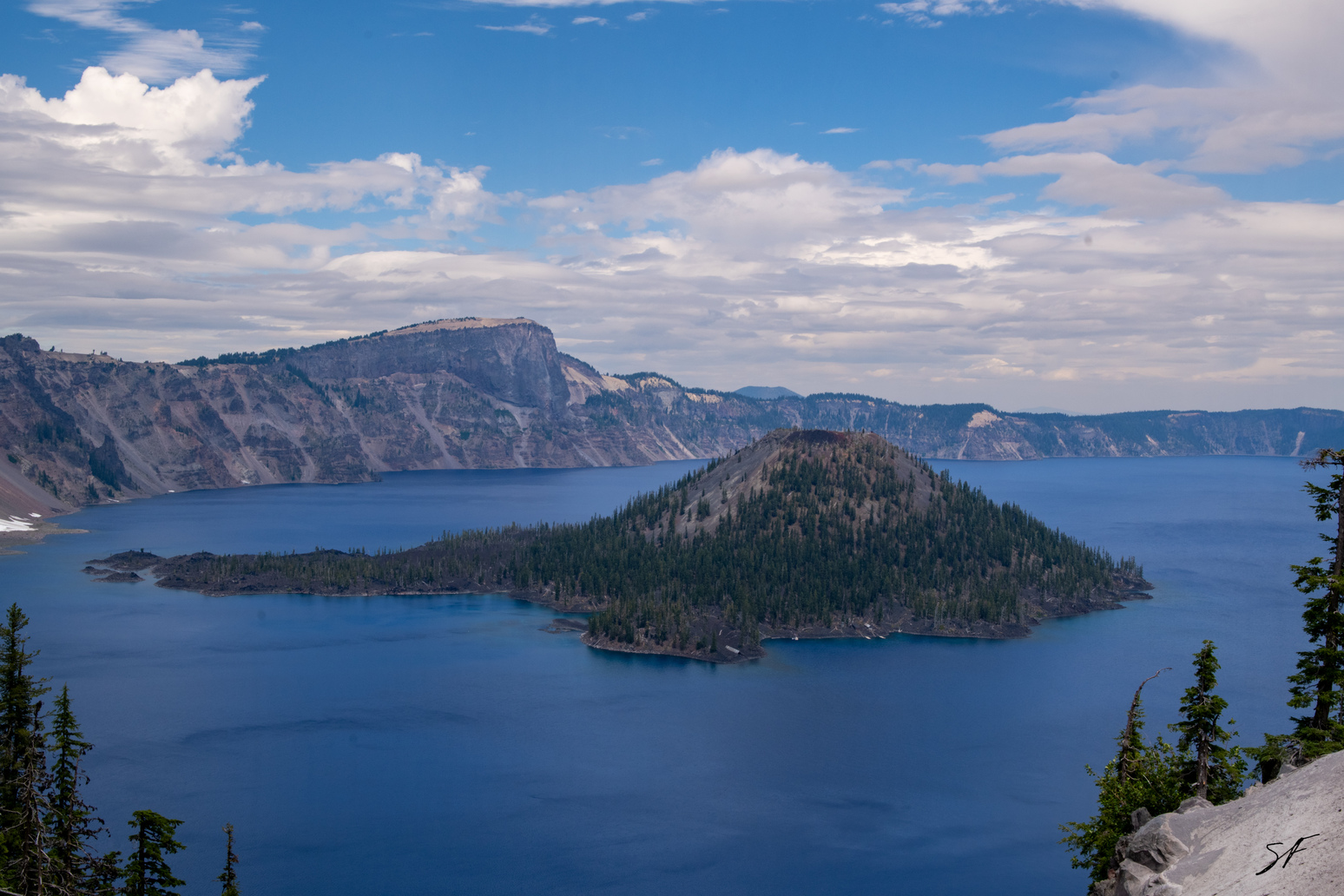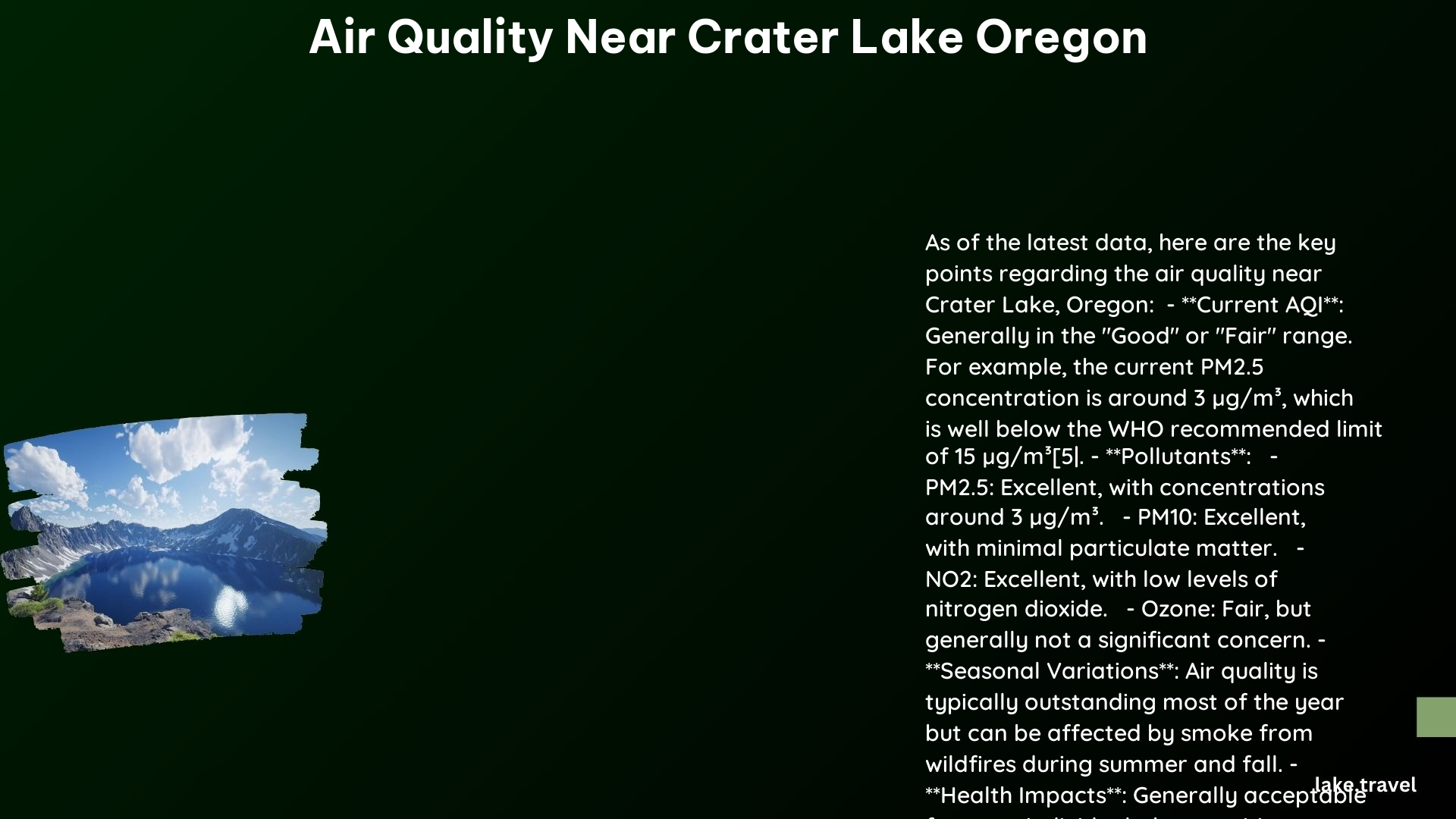The air quality near Crater Lake, Oregon, is generally good but can fluctuate due to various factors. Located in a Class I air quality area, Crater Lake National Park enjoys high protection under the Clean Air Act. However, seasonal changes, particularly wildfire smoke in summer and fall, can significantly impact air quality. Current measurements show an Air Quality Index (AQI) of 18, categorized as “GOOD,” with PM2.5 levels well below WHO recommendations. Visitors should stay informed about air quality conditions, especially during fire seasons, to ensure a safe and enjoyable experience at this pristine natural wonder.
What Are the Current Air Quality Measurements at Crater Lake?

The latest air quality measurements near Crater Lake, Oregon, paint a positive picture for visitors and residents alike. Here’s a breakdown of the current conditions:
- Air Quality Index (AQI): 18 (GOOD)
- PM2.5 Concentration: 10.8 µg/m³
- Comparison to WHO Guidelines: 0.12 times the recommended limit
These figures indicate excellent air quality, with pollutant levels well within safe ranges. Let’s delve deeper into what these numbers mean for your visit to Crater Lake:
- PM2.5 Levels: At 10.8 µg/m³, the fine particulate matter concentration is comfortably below the World Health Organization’s 24-hour mean threshold of 15 µg/m³.
- Other Pollutants: Ground-level ozone (O3), nitrogen dioxide (NO2), and PM10 are all within excellent or fair ranges.
- Health Implications: These levels pose minimal health risks for most individuals, including those with respiratory sensitivities.
How Do Seasonal Changes Affect Air Quality at Crater Lake?

Air quality at Crater Lake experiences notable fluctuations throughout the year, primarily due to natural and human-induced factors. Understanding these seasonal patterns can help you plan your visit more effectively:
Summer and Fall
- Primary Concern: Wildfire smoke
- Impact: Significant degradation of air quality and visibility
- Health Risks: Increased for sensitive groups
Winter
- Factors: Lower temperatures, increased particulate matter
- Sources: Woodstove burning, local emissions
- Severity: Generally less severe than wildfire impacts
Late October to Winter
- Trend: General deterioration in air quality
- Peak: Winter often experiences the worst air quality
- Cause: Increased particulate matter from various sources
To better illustrate these seasonal variations, consider the following table:
| Season | Primary Air Quality Concern | Severity | Recommended Precautions |
|---|---|---|---|
| Summer | Wildfire Smoke | High | Check daily AQI, limit outdoor activities during poor air quality days |
| Fall | Wildfire Smoke | Moderate to High | Stay informed about local fires, follow health advisories |
| Winter | Particulate Matter | Moderate | Be aware of indoor air quality, especially if using wood-burning stoves |
| Spring | Generally Good | Low | Enjoy outdoor activities, but stay informed about any sudden changes |
What Is the Impact of Wildfire Smoke on Crater Lake’s Air Quality?
Wildfire smoke poses the most significant threat to air quality near Crater Lake, particularly during the summer and fall seasons. Its impact extends beyond mere discomfort, affecting both visibility and health:
Visibility Impacts
- Smoke can severely limit views of the lake
- Scenic vistas may be obscured during heavy smoke events
- Photography and sightseeing experiences may be compromised
Health Concerns
- Eye and throat irritation
- Coughing and difficulty breathing
- Aggravation of existing respiratory conditions like asthma
- Potential for more severe health effects with prolonged exposure
AQI Fluctuations
During periods of significant wildfire activity, the Air Quality Index can rise dramatically, sometimes reaching unhealthy levels. This can lead to:
- Health advisories being issued
- Recommendations to reduce or avoid outdoor activities
- Potential closures of certain park areas or trails
How Does Ozone Concentration Affect Air Quality at Crater Lake?
While often overshadowed by concerns about particulate matter from wildfires, ozone concentration plays a crucial role in the overall air quality near Crater Lake. Here’s what you need to know:
Current Ozone Levels
- Status: Excellent
- Health Risks: Minimal for most visitors
Potential Effects of Elevated Ozone
Even though current levels are low, it’s important to understand the potential impacts of higher ozone concentrations:
- Aggravation of existing respiratory diseases
- Throat irritation and coughing
- Chest pain and difficulty breathing
- Increased susceptibility to respiratory infections
Long-term Exposure Risks
For park staff or frequent visitors, prolonged exposure to elevated ozone levels could lead to:
– Reduced lung function
– Increased frequency of asthma attacks
– Higher susceptibility to lung infections
What Guidelines Should Visitors Follow Regarding Air Quality at Crater Lake?
To ensure a safe and enjoyable visit to Crater Lake National Park, especially concerning air quality, follow these guidelines:
-
Check Air Quality Reports: Before and during your visit, regularly check real-time air quality data provided by the park’s monitoring stations.
-
Health Advisories: Pay close attention to any health advisories issued by the park, especially during wildfire season.
-
Adjust Activities: During periods of poor air quality:
- Reduce time spent outdoors
- Opt for indoor activities at visitor centers
-
Consider rescheduling strenuous outdoor activities
-
Know Your Sensitivity: If you have respiratory issues, heart disease, or are in a sensitive group (children, elderly), take extra precautions.
-
Recognize Symptoms: Be aware of symptoms like difficulty breathing, throat irritation, or unusual fatigue, which may indicate poor air quality effects.
-
Hydration: Stay well-hydrated, especially on days with higher ozone levels or during smoke events.
-
Mask Usage: Consider using N95 masks during severe smoke events if outdoor activities are unavoidable.
-
Vehicle Use: Minimize unnecessary vehicle idling to reduce emissions within the park.
-
Respect Fire Regulations: Adhere strictly to fire regulations to prevent human-caused wildfires that could impact air quality.
-
Stay Informed: Familiarize yourself with the park’s Class I air quality designation and its implications for conservation efforts.
By following these guidelines, you can help protect both your health and the pristine environment of Crater Lake National Park while enjoying its breathtaking beauty.
